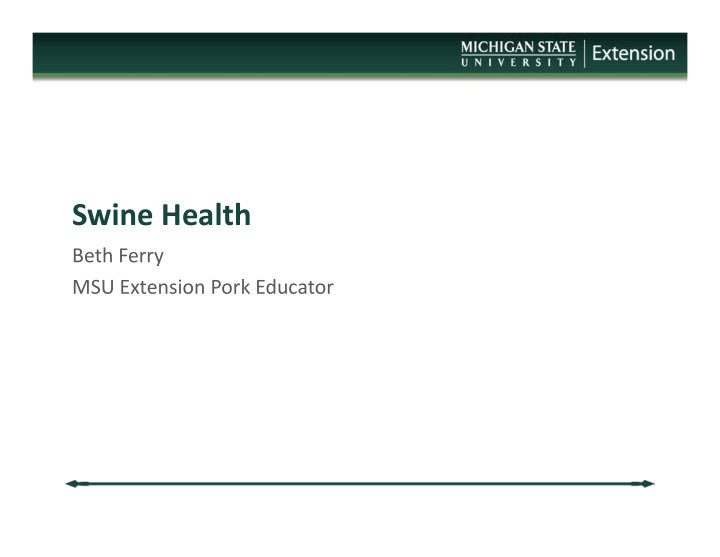



Swine Health Beth Ferry MSU Extension Pork Educator
What Affects Pig Health? • Environment • Nutrition Resources • Animal Care Management
What is your job? • Good Observation • Key to managing health, production and animal behavior • Most be done EVERYDAY! • One of the hardest thing to do well • Who do you talk to when something is wrong
Things to look for! • Is your pig getting up • Does your pig eat • How does your pig move • What does the hair coat look like • Check the eyes, ears and nose of the pig
What are Major Diseases in the Pork Industry? • PRRS – Porcine Respiratory Reproductive Syndrome • PEDv – Porcine Epidemic Diarrhea Virus • SIV – Swine Influenza Virus
PRRS • Was found in the 1980s and originally called Mystery Swine Disease • Also called blue ear pig disease • Officially named in 1991 • Affects the macrophages – “disease fighters” • Makes pigs get sick easier • Many different PRRS strain identified
What does PRRS Do? • Piglets � Sows � Go off feed More diarrhea. • � A reluctance to drink. Less viable piglets. • � No milk and mastitis ‐ significant Increase in respiratory • symptoms. infections � High rate of abortions. • Growing pigs � Farrowings are often 2 ‐ 3 days early. � Respiratory/breathing issues. Go off feed • � Mummified piglets. 10 ‐ 15% may die Mild coughing. • in the last 3 ‐ 4 weeks of pregnancy. Hairy wasting pigs. • � Stillbirth levels increase up to 30%. In some herds there are no • � Very weak piglets at birth. symptoms
What should show pig people do? • Minimal PRRS virus signs in exhibition pigs • Michigan is a PRRS “light” state • We have PRRS on our farms • Most strains do not cause many issues • Vaccines available – this should happen at the sow farm • Estimated to cost the US pork industry is over 6 million dollars a year. • $12 to $15 per pig marketed
PEDv • New disease to the United States – found April 2013 • Causes severe watery diarrhea in pigs and vomiting. • The first strain of PED virus found in the United States is 99% homologous (similar) to the Asian strain which remains virulent. • At this time multiple strains are suspected in the US
What does PEDv do to pigs? • Cause increased vomiting and diarrhea in pigs • Death is caused by dehydration • Piglets • Mortality in piglets is high (up to 80%) due to dehydration • Sows • Mortality in sows is lower, diarrhea present • Growing pigs • Clinical signs of fever, vomiting and diarrhea • Increased mortality but not significant like in suckling pigs
Is PEDv in Michigan? • Yes!!! • First found in the summer 2013 • Wide spread this winter • Intially thought to spreads via trucks and trailers, manure and other pigs • Possible aerosol transmission • Possible feed contamination Still lots of questions regarding PEDv out there, no good answers !
What should show pig people do? • There is no treatment NOR effective vaccine available for PED • Focus should be made on prevention and control = BIOSECURITY! • Minimal contact with other pigs/areas with pigs • PED and TGE mimic each other in clinical signs and a true diagnosis of PED will require sampling and testing • Contact your veterinarian if you see signs of PEDv
SIV • Influenza is a virus that acts like a common cold in pig • Various different strains are present • Some strains are zoonotic – can be transferred from animals to humans • In 2009, 2012 and 2013 we saw zoonotic strains of SIV in human and pig populations
What does SIV do to pigs? • Happens most often during low immunity or high stress • Transport • Commingling of pigs • Off – feed events • Fever • Dry (Bark) Coughing
What should show pig people do? • Treatment of symptoms, not viruses • Pain, fever • Vaccination program • 2 dose vaccine available • First dose around 21 days of age, second dose 3 to 4 weeks later • Will not eliminate all SIV strains but will decrease symptoms • Helps protect pigs and people – reduction of clinical signs
http://www.youtube.com/watch?v=rAGHXMq9ttw&feature=player_embedded
Testing for different diseases
Prevention • Biosecurity practices • Keep pigs separated from avian species • Isolate new pigs from the rest of the herd before we introduce them into the new herd • Use clean and disinfected trucks and trailers to transport pigs • Change boots and clothes when you come into contact with other pigs • Practice good hygiene – wash you hands!
Final Thoughts! • Remember as a youth pork producer it is your responsibility to protect the health of your pigs and the people that come into contact with pigs!
Questions!
Recommend
More recommend